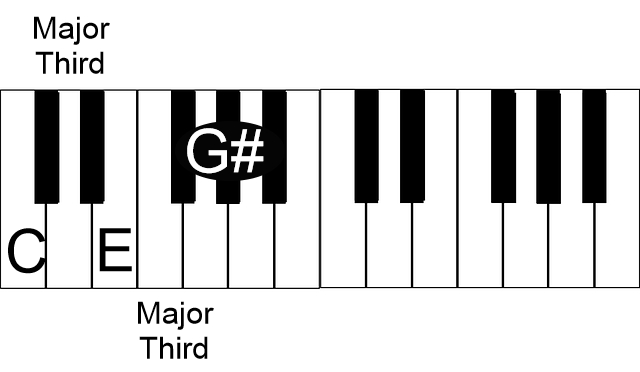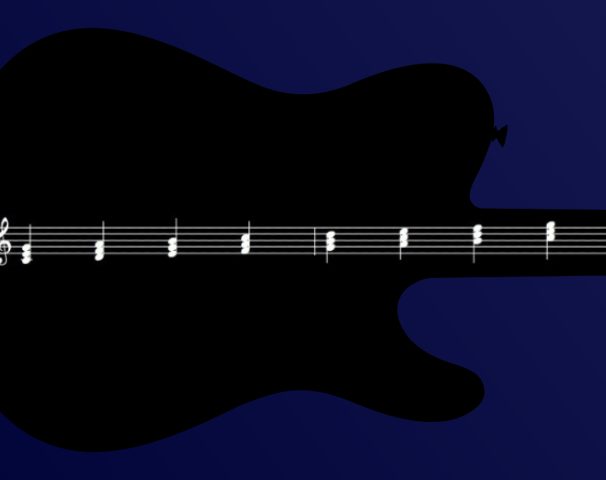
Harmonizing the minor scale works just the same as building a harmonized major scale. We stick strictly to diatonic notes from the scale to find the chords of the harmonized minor scales. But since there are three forms of the minor scale, things get a bit more complicated. We’ll take a look at all of that here.
What is a harmonized minor scale?
Harmonizing the minor scale means building a series of seven chords starting with the root. Each of the chords uses only notes from the minor scale. The three forms of the minor scale—the natural minor, the harmonic minor, and the melodic minor—have different sets of harmonized chords since each uses some different notes from the others.
If you need to know more about the basics of harmonized scales, read
How does harmonizing the minor scale work for the natural minor scale?
In general, you follow the same procedure to harmonize any minor scale as you do to harmonize the major scale. The natural minor is the most similar to the major scale in the construction of its harmonized scale.
You can sort of think of it as the inverse of the harmonized major scale. What I mean is that in the harmonized major scale, the I, IV, and V chords are major while the II, III, and VI chords are minor.
As you’ll see in a moment, in the natural minor scale, the I, IV, and V are minor. The remaining chords don’t correlate as precisely as opposites of the major scale, but they’re close.
If you haven’t studied up on minor scales yet, stop now and read
Harmonizing the natural minor key in A minor
Let’s use the key of A minor to build our example since that key’s natural minor scale uses no sharps or flats. Thus it’s easy to visualize with the piano keyboard.
The notes of the A natural minor scale are:
A, B, C, D, E, F, G

We’ll use only those notes to create the chords of the A natural harmonized minor scale.
As usual, we start with the root note and build our first chord. The notes of the first chord are A, C, and E.
Notice the structure of this chord. It consists of a whole step between the first two notes of the chord. That’s a minor 3rd interval. Then it has a whole step and a half between the second and third notes of the chord. That’s a major 3rd interval.
A minor 3rd interval followed by a major 3rd interval creates a minor chord. This explains why the root chord is a minor. In this case, specifically A minor. But the root chord of any minor scale is by definition minor.
Building the rest of the harmonized natural minor scale
Now to find the next chord in the harmonized natural minor scale, we move each of the notes up to the next diatonic note. Thus, the A moves to B. The C moves to D. And finally the E moves to F.
Play this chord on your piano keyboard and notice that it contains minor thirds in both halves of the chord. These double minor thirds makes this chord a diminished chord. So the second chord of the harmonized natural minor scale is Bdim.
You can follow this procedure to find the rest of the chords. When you do so, you’ll find that the chords of the A natural minor harmonized scale are:
Am, Bdim, C, Dm, Em, F, G
This pattern is the same for all natural harmonized minor keys. In scale degree numbering, the pattern looks like:
i, iidim, III, iv, v, VI, VII
How does harmonizing the minor scale work for the harmonic minor scale?
Sticking with the key of Am, let’s build the harmonic minor harmonized scale. Here things start to get a bit more complicated, but you can still work it out easily enough.
Remember, to create the harmonic minor scale, you simply use a non-flatted 7th note of the scale. So the notes of the A harmonic minor scale are:
A, B, C, D, E, F, G#
Therefore, as you build the chords of the harmonized scale, you have to remember to use G# instead of G. This doesn’t affect the first two chords. They remain the same as in the natural minor.

But the third chord in the natural minor scale contains a G. We need to make this note a G#. So the third chord contains the notes. G, E, and G#.
This is a different type of chord that we haven’t run into before. Notice that the first half of the chord contains a major 3rd interval, so this looks like it will be a major chord. However, the second half of the chord also contains an interval of a major 3rd.
A new chord type: the augmented chord
A chord that has a major 3rd interval between the root and third degree notes and an interval of a major 3rd between the third and fifth degree notes is known as an Augmented chord.
So the third chord in the scale is C augmented, usually written as Caug, C+, or C+5.
Completing the pattern for the harmonic minor
As you continue building the chords, you’ll find that the 4th is minor, the 5th and 6th are major, and the 7th is another diminished chord. So the chords of the A harmonic minor harmonized scale are:
Am, Bdim, Caug, Dm, E, F, G#dim
The general pattern for the harmonized natural minor scale in any key is:
i, iidim, IIIaug, iv, V, VI, viidim
Interesting how changing just that one note of the scale changes the structure of so much of the harmonized scale.
How does harmonizing the minor scale work for the melodic minor scale?
The melodic minor scale changes one more note from the natural minor. In this case, along with the non-flatted 7th, we have a non-flatted 6th to close down the interval between degrees 6 and 7. In the case of A minor then, the F note becomes F#. So, the notes of the A melodic minor scale are:
A, B, C, D, E, F#, G#
And of course, this changes the structure of the chords in the harmonized scale for the melodic minor. You can work them out in exactly the same way as you’ve been doing for the other scales. When you do, you’ll find that the chords of this harmonized scale are:
Am, Bm, Caug, D, E, F#dim, G#dim
So the pattern for the harmonized melodic minor scale in any key is:
i, ii, IIIaug, IV, V, vidim, viidim
Why does understanding harmonizing the minor scale matter?
As guitar players it might be that non of this really matters much to us, depending upon our playing style.

Basic rhythm guitar parts
If we’re just following chord charts to play along as rhythm guitarists with the most basic chords possible, we’ll simply play the chords that the chart calls for. When it calls for a minor chord, we’ll play it. If it calls for a diminished chord, we’ll play that. And we can easily do so without any understanding of why the first chord was minor and the second diminished. There’s really no problem with this.

More sophisticated parts
However, if you’re going to play more sophisticated chord inversions or if you’re playing lead guitar and you need to solo over the changes, you’re going to more likely need an understanding of what’s going on with the progression.
Learning songs by ear
Finally, being familiar with these patterns helps you to determine the scale used for a song that you might be trying to learn by ear. For instance, say you’ve determined that the root chord of a song you’re trying to learn is Em. So clearly it’s in a minor key. But which scale does it use?
You know that A is the IV of the scale. So you determine whether the A in this song is a major or a minor. If it’s a major chord, that indicates the song uses the melodic minor scale since that’s the only one of the three that uses a major 4th degree chord.
If the A turns out to be a minor, then you look for the 5th chord of the scale, the B. And let’s say you find it and determine that is a B7—a major dominant 7th chord. Since the natural minor key uses a minor V, and the harmonic minor scale uses a major V, you are most likely dealing with the harmonic minor scale.
Again, it might seem a bit complicated, but you just have to think it through logically.
Conclusion
Just as with major keys, harmonizing the minor scale is a simple concept. But since the minor key can take one of three forms, things get a little more complicated.
Still the procedure for figuring out the chords of these three minor scale forms is the same as the basic major procedure. Start with the root chord. Then raise each note of the chord one diatonic note at a time to find the second chord and all the subsequent chords.
With the natural minor scale, this remains pretty much as easy as figuring out the major harmonized scale. The other two forms change which notes are diatonic and thus complicates things a bit.
Still, if you just follow the steps, you can easily determine the nature of the chords in each of the three harmonized minor scales.

merci vous étiez très explicite. toutefois la gamme mineure harmonique m’échappe un peu mais je persiste.
Continue, tu y arriveras ! Bonne chance.
thanks very helpful and concise article. larry hamburg
You’re welcome, Larry. I’m glad you found it useful. Good luck with your playing!
That is helpful. Thank you.